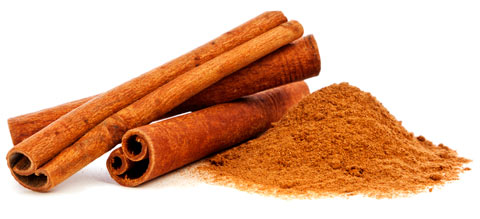Cinnamon's Anticancer Benefits

Fun Facts:
In India, cinnamon is used by some doctors and midwives to control the pain of labor during childbirth.(i.1)
Cinnamon was so valuable that it was at the center of years of spice and trade conflicts between Portugal, Holland, England, and France in the 16th century.(i.148)
Cinnamon is one of the oldest herbs used for food and medicine. The spice comes from the bark of a small tropical evergreen tree in the Lauraceae plant family, and is among the few spices found in the Bible, Egyptian, Sumerian and Chinese documents mentioned as far back as 2800 BC. Although there are about 100 types of cinnamon, there are only 2 varieties commonly used as a spice — Cinnamomum zeylanicum and Cinnamomum cassia. Cinnamomum zeylanicum is called Ceylon cinnamon because it is believed to have originated from Sri Lanka (also known as Ceylon). This true cinnamon has a lighter color and is sweeter than C. zeylanicum, which is the most common variety used in the United States. (i.146-148)
Nutrient Analysis
The principle bioactive ingredients found in both varieties of cinnamon are in the essential oils, which have special healing properties primarily due to three active compounds: cinnamyl alcohol, cinnamyl acetate and cinnamaldehyde. Other important compounds in cinnamon, including cancer-fighting polyphenols, vitamins, and minerals, include: (i.147, 149-151)
|
|
The Effect of Cinnamon on Cancer
Cinnamon has several biological functions, including antioxidant, antimicrobial, and anti-inflammatory properties. It has more powerful antioxidant properties than many other common antioxidant spices (such as ginger, vanilla, licorice, nutmeg and anise), as well as more antioxidant protection than the common food preservatives BHA and BHT. (i.147)
In addition to its cancer-fighting antioxidant protection and anti-inflammatory properties, scientific research has shown that cinnamon extracts help to suppress the progression of cancerous tumors via a number of other mechanisms. Some of ways cinnamon works to fight cancer include: (i.152, 153)
- Inhibits growth factors (proteins that promote tumor growth).
- Increases anti-tumor activities of the immune system's CD8+ T cells.
- Prevents metastasis by impeding growth of new blood vessels stimulated by tumor cell stimulation of HIF-1, a transcription-type protein that activates genes which produce factors promoting tumor spread.
- Significantly reduces levels of Cox-2, an inflammatory enzyme that suppresses the immune system and promotes tumor progression and metastasis
- Causes cancer cell death by inhibiting inflammatory factors NF-κB and AP1
Lab and animal studies suggest cinnamon extracts, whether taken orally or injected into tumors, may be an effective treatment against melanoma skin cancer. Other studies report that cinnamon can induce cell death and inhibit tumor growth in breast cancer, colorectal cancers, and liver cancer cell lines. The combination of calcium and fiber in cinnamon also helps in removing bile and protects colon cells from damage, which in turn helps to prevent colon cancer. (i.147, 152)
In one clinical study, cinnamon significantly lowered blood sugar levels in people with type-2 diabetes — a disease that is often part of metabolic syndrome, a conglomerate of inflammatory conditions. Metabolic syndrome is associated with increased cancer risk, as is diabetes. In fact, population studies show a significant association between diabetes and insulin resistance and significantly higher rates of bladder, colorectal, breast, pancreatic, liver, and uterine cancers. Although there was not an associated higher rate in the development of prostate cancer in diabetic men, those prostate cancer patients with diabetes were more likely to have it reoccur or die from the disease. Breast cancer patients with diabetes also showed worse outcomes as well. Cinnamon's ability to help regulate glucose levels in diabetics suggests that it may also help lower the risk of these types of cancers as well. (i.1, 154-156)
Adding Cinnamon to Your Diet
The bark of the cinnamon tree is generally used as spice in its dry form. It is usually available as ground powder or in tubular form. The American Institute for Cancer Research offers some interesting recipes full of cancer-fighting ingredients. One particularly tasty one you might try that includes cinnamon, ginger, pepper, orange juice, carrots, and whole dried apricots. (i.146, 147, 157)
Cinnamon may also be added to a variety of things, including with honey in warm soy milk or as an ingredient in meat and eggplant dishes for a Persian flair. Try adding cinnamon to curries, or even in beans used for popular Mexican foods such as burritos and nachos. (i.147)
Buying and Storing Cinnamon
Although ground cinnamon provides a stronger flavor, the sticks can be stored longer. The sticks can remain fresh for more than a year while the powder can remain fresh for about six months if stored well. The spice should be stored in a dry, dark, and cool place in a glass container with tight seal. Storing the spice in the refrigerator helps to extend its shelf life even more. (i.147)
Even ground, cinnamon tends to have a sweet odor if it is fresh-throw it away if it doesn't. It is better to choose organically grown types to avoid issues such as irradiation, which negatively affects the carotenoids and vitamin C in cinnamon. (i.147)
Growing Cinnamon
Cinnamon trees grow best in tropical areas, especially in low altitudes with hot and moist climates. The trees are usually maintained at the size of a small bush, although they can reach a height of 65 feet when left to grow. C. zeylanicum is a little hardier than C. cassia, which can only survive outside in temperatures above 20°F. In the United States, the sandy soil and warm temperatures of Florida have proven to be suitable for cinnamon trees. In fact, you can purchase both varieties of potted cinnamon trees or planting online. One seller who carries both is Top Tropicals, located in Punta Gorda, Florida. (i.158, 159)
Harvesting the spice from the cinnamon tree is an involved process that requires patience as it takes 2-8 years for the tree to mature. The stems of the mature trees are cut and the outer bark and inner lining are scraped off. As the inner stems or shoots dry, they curl into quills that are rolled together to form cinnamon sticks. (i.148, 158)
Be Careful of Coumarins and Hormonal Effects of Cinnamon
Cinnamon has GRAS status in the United States, meaning it is generally recognized as safe for human use. There are typically no allergic reactions associated with cinnamon. (i.147, 160)
Cassia cinnamon has relatively high levels of coumarins, which may be harmful to the liver in some people when taken regularly in higher amounts (50-7000 mg/day), especially those with liver conditions. Lab studies indicate that cinnamon extract acts in both estrogenic and anti-estrogenic ways, and experts advise caution in using it if you have cancer affected by hormone levels. (i.153, 161)



